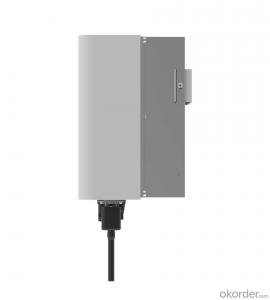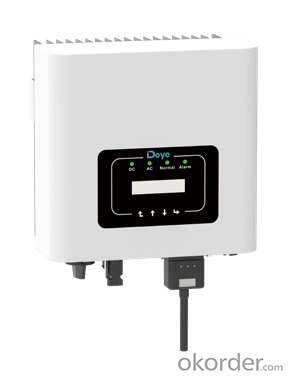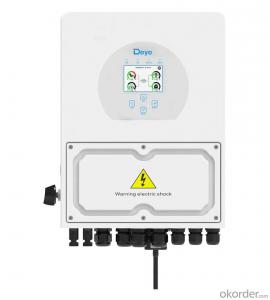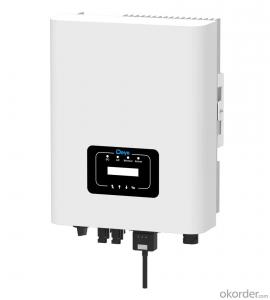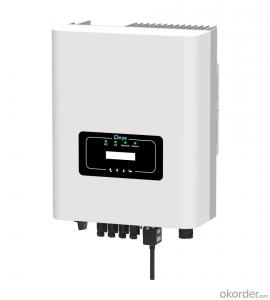Solar Inverter Dealer - sun-1/1.5/2/2.5/3k-g | 1.5-3kw | Single Phase | 1 MPPT
- Loading Port:
- Ningbo
- Payment Terms:
- TT OR LC
- Min Order Qty:
- 100 pc
- Supply Capability:
- 5000 pc/month
OKorder Service Pledge
OKorder Financial Service
You Might Also Like
Specification
The innovative design of the SUN-1/1.5/2/2.5/3K-G is not only easy to install, but also allows for quick DC and AC connections. E.g. it weighs just 6 kg. Commissioning is equally easy, because the integrated user interface (local LCD display and buttons) makes it possible to choose the necessary settings quickly.
· 1 MPP tracker, Max. efficiency up to 97.5%
· Zero export application,VSG application
· String intelligent monitoring (optional)
· Wide output voltage range
· Anti-PID function(Optional)
| Technical Data | ||||||
| Model | SUN-1K-G | SUN-1.5K-G | SUN-2K-G | SUN-2.5K-G | SUN-3K-G | |
| Input Side | ||||||
| Max. DC Input Power (kW) | 1.3 | 2 | 2.6 | 3.3 | 3.9 | |
| Max. DC Input Voltage (V) | 550 | |||||
| Start-up DC Input Voltage (V) | 80 | |||||
| MPPT Operating Range (V) | 70~500 | |||||
| Max. DC Input Current (A) | 13 | |||||
| Max. Short Circuit Current (A) | 19.5 | |||||
| Number of MPPT / Strings per MPPT | 1/1 | |||||
| Output Side | ||||||
| Rated Output Power (kW) | 1 | 1.5 | 2 | 2.5 | 3 | |
| Max. Active Power (kW) | 1.1 | 1.7 | 2.2 | 2.75 | 3.3 | |
| Nominal Output Voltage / Range (V) | L/N/PE 220V/0.85Un-1.1Un, 230V/0.85Un-1.1Un (Optional) | |||||
| Rated Grid Frequency (Hz) | 50 / 60 (Optional) | |||||
| Operating Phase | Single phase | |||||
| Rated AC Grid Output Current (A) | 4.3 | 6.5 | 8.7 | 10.9 | 13 | |
| Max. AC Output Current (A) | 4.8 | 7.2 | 9.6 | 12 | 14.3 | |
| Output Power Factor | 0.8 leading to 0.8 lagging | |||||
| Grid Current THD | <3%< td=""> | |||||
| DC Injection Current (mA) | <0.5%< td=""> | |||||
| Grid Frequency Range | 47~52 or 57~62 (Optional) | |||||
| Efficiency | ||||||
| Max. Efficiency | 97.3% | 97.3% | 97.3% | 97.3% | 97.5% | |
| Euro Efficiency | 97.1% | 97.1% | 97.1% | 97.1% | 97.3% | |
| MPPT Efficiency | >99% | |||||
| Protection | ||||||
| DC Reverse-Polarity Protection | Yes | |||||
| AC Short Circuit Protection | Yes | |||||
| AC Output Overcurrent Protection | Yes | |||||
| Output Overvoltage Protection | Yes | |||||
| Insulation Resistance Protection | Yes | |||||
| Ground Fault Monitoring | Yes | |||||
| Anti-islanding Protection | Yes | |||||
| Temperature Protection | Yes | |||||
| Integrated DC Switch | Yes | |||||
| Remote software upload | Yes | |||||
| Remote change of operating parameters | Yes | |||||
| Surge protection | DC Type II / AC Type II | |||||
| General Data | ||||||
| Size (mm) | 280W×272.5H×184D | |||||
| Weight (kg) | 4.8 | |||||
| Topology | Transformerless | |||||
| Internal Consumption | <1W (Night) | |||||
| Running Temperature | -25~65℃, >45℃ derating | |||||
| Ingress Protection | IP65 | |||||
| Noise Emission (Typical) | <25 dB | |||||
| Cooling Concept | Natural cooling | |||||
| Max. Operating Altitude Without Derating | 2000m | |||||
| Warranty | 5 years | |||||
| Grid Connection Standard | CEI 0-21, VDE-AR-N 4105, NRS 097, IEC 62116, IEC 61727, G99, G98, VDE 0126-1-1, RD 1699, C10-11 | |||||
| Operating Surroundings Humidity | 0-100% | |||||
| Safety EMC / Standard | IEC/EN 61000-6-1/2/3/4, IEC/EN 62109-1, IEC/EN 62109-2 | |||||
| Features | ||||||
| DC Connection | MC-4 mateable | |||||
| IP65 rated plug | ||||||
| Display | LCD1602 | |||||
| Interface | RS485/RS232/Wifi/LAN | |||||
- Q: What are the potential risks of electrical shock from a solar inverter?
- The potential risks of electrical shock from a solar inverter include: 1. Improper installation or faulty wiring, which may result in exposed live wires and increase the chances of electric shock. 2. Inadequate grounding or lack of proper safety measures, leading to the possibility of electrical leakage and shock hazards. 3. Accidental contact with energized components during maintenance or repair work, especially if proper safety precautions are not followed. 4. Inverter malfunctions or defects, such as insulation breakdown, which can expose individuals to electric shock. 5. Working with solar inverters in wet or damp conditions, as moisture can increase the conductivity of electricity and heighten the risk of shock. 6. Ignoring warning signs or not following manufacturer guidelines for safe operation and maintenance, which can contribute to electrical shock incidents.
- Q: Can a solar inverter be used with a solar-powered greenhouse system?
- Yes, a solar inverter can be used with a solar-powered greenhouse system. A solar inverter converts the direct current (DC) produced by solar panels into alternating current (AC) that can be used to power electrical devices. In a solar-powered greenhouse system, solar panels generate electricity from the sun's energy, which is then converted by the inverter to power the various components of the greenhouse, such as fans, lights, and irrigation systems.
- Q: Can a solar inverter be used with a solar-powered backup generator?
- Certainly, a solar-powered backup generator can indeed be utilized in conjunction with a solar inverter. The solar inverter's primary function is to convert the DC electricity generated by solar panels into AC electricity, which is suitable for powering household appliances and various electrical devices. Conversely, a solar-powered backup generator harnesses solar energy to either charge its batteries or store any surplus electricity. When the solar panels are actively generating electricity, the solar inverter will convert the DC electricity into AC electricity. This AC electricity can then be directly employed within the household or redirected back to the grid, assuming the system is interconnected. Should there be an excess of electricity being produced and the batteries of the solar-powered backup generator are fully charged, the solar inverter has the capability to divert this surplus electricity to other loads or devices. During periods when solar energy is either insufficient or unavailable, the solar-powered backup generator can seamlessly activate and provide the requisite electricity to power the house or recharge the batteries. In such cases, the solar inverter remains responsible for the conversion of the DC electricity generated by the solar-powered backup generator into AC electricity. To summarize concisely, employing a solar inverter alongside a solar-powered backup generator guarantees a continuous supply of electricity, even during instances of limited solar energy availability.
- Q: How does a solar inverter handle variations in AC load demand?
- A solar inverter handles variations in AC load demand by continuously monitoring the load demand and adjusting the amount of power it delivers from the solar panels accordingly. This is achieved through advanced control algorithms that optimize the conversion of DC power generated from the solar panels into AC power that matches the load demand. The inverter maintains a stable voltage and frequency output, ensuring that the electrical devices connected to it receive a consistent and reliable power supply, even when there are fluctuations in the AC load demand.
- Q: What is the role of a solar inverter in protecting the electrical grid?
- The role of a solar inverter in protecting the electrical grid is to convert the direct current (DC) electricity produced by solar panels into alternating current (AC) electricity that is compatible with the grid. It ensures that the solar power generated is synchronized with the grid's voltage and frequency, allowing for seamless integration and preventing any disruptions or voltage fluctuations that could potentially harm the grid. Additionally, solar inverters have built-in safety mechanisms such as anti-islanding protection, which disconnects the solar system from the grid during a power outage, ensuring the safety of utility workers who may be working on the grid. Overall, solar inverters play a crucial role in ensuring the stability, reliability, and safety of the electrical grid when incorporating solar energy.
- Q: How does a solar inverter handle voltage fluctuations in the grid?
- A solar inverter handles voltage fluctuations in the grid by continuously monitoring the grid voltage. When the voltage deviates from the standard range, the inverter adjusts its output accordingly to stabilize the voltage and ensure a consistent supply of power.
- Q: What is the importance of voltage and frequency control in a solar inverter?
- Voltage and frequency control are crucial in a solar inverter as they ensure the stability and reliability of the electrical system. Voltage control regulates the output voltage of the inverter, ensuring it is within safe limits and compatible with the grid or the connected appliances. This is important to protect the electrical devices from overvoltage or undervoltage conditions, which could potentially damage them. Frequency control, on the other hand, maintains the output frequency of the inverter in synchronization with the grid frequency. This synchronization is vital for the seamless integration of the solar power into the existing electrical grid. Inconsistent frequencies can lead to instability, power quality issues, and potential damage to equipment. Overall, voltage and frequency control in a solar inverter play a significant role in maintaining a reliable and efficient electrical system, safeguarding the connected appliances, and ensuring the proper integration of solar power into the grid.
- Q: Can a solar inverter be used in regions with high levels of dust or debris?
- Yes, solar inverters can be used in regions with high levels of dust or debris. However, it is important to regularly clean and maintain the solar panels and inverters to ensure optimal performance and prevent any potential damage caused by the accumulation of dust or debris.
- Q: Can a solar inverter be used in areas with unstable grid connections?
- Yes, a solar inverter can be used in areas with unstable grid connections. Solar inverters are designed to convert the DC power generated by solar panels into AC power that can be used to power electrical devices or be fed back into the grid. In areas with unstable grid connections, a solar inverter can help stabilize the power supply by switching to off-grid mode when the grid connection is unstable or completely lost. This allows the solar system to continue generating and supplying power to the connected loads even during grid outages or fluctuations.
- Q: What is the role of a remote monitoring system in a solar inverter?
- The role of a remote monitoring system in a solar inverter is to provide real-time data and analysis of the performance and operation of the solar inverter. It allows for remote access and control, enabling solar system owners and operators to monitor the energy production, detect any issues or faults, and optimize the performance of the solar inverter from a remote location.
Send your message to us
Solar Inverter Dealer - sun-1/1.5/2/2.5/3k-g | 1.5-3kw | Single Phase | 1 MPPT
- Loading Port:
- Ningbo
- Payment Terms:
- TT OR LC
- Min Order Qty:
- 100 pc
- Supply Capability:
- 5000 pc/month
OKorder Service Pledge
OKorder Financial Service
Similar products
Hot products
Hot Searches
Related keywords

